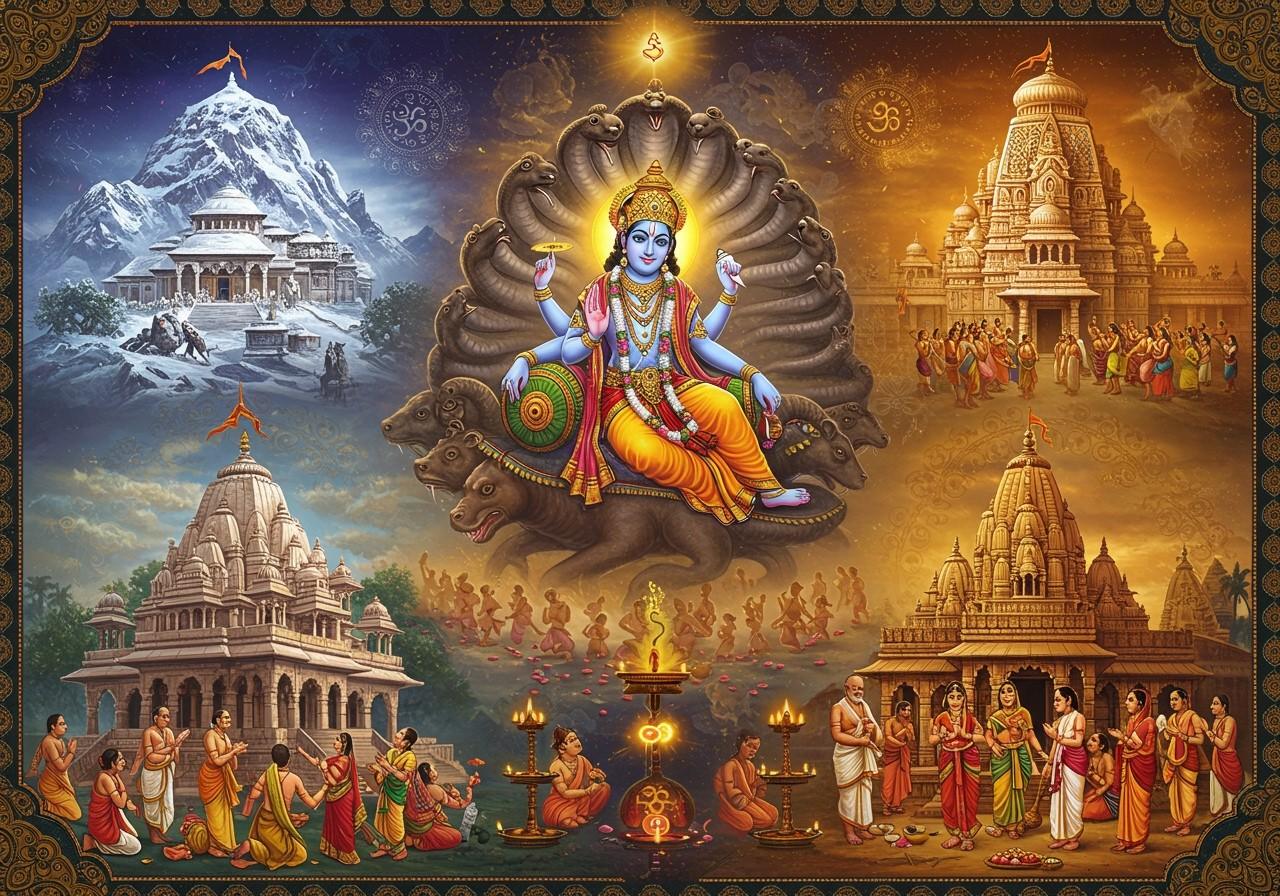
Vaishnavism, a revered tradition within Hinduism, centers on the worship of Vishnu and his incarnations, notably Krishna and Rama. This tradition has evolved uniquely across India, shaped by local customs, languages, and cultural practices. We’ll explore the distinct expressions of Vaishnavism in Assam, Odisha, and Bengal, highlighting how these regions have enriched this devotional path.
Vaishnavism in Assam
Unique Cultural Expressions
Assam’s Vaishnavism is deeply rooted in the teachings of Srimanta Sankardev, who introduced the Eka Sarana Nama Dharma emphasizing devotion to Vishnu. Sankardev’s influence is evident in Assam’s distinctive cultural expressions:
- Borgeet: These devotional songs, integral to Assamese Vaishnavism, evoke deep emotional and spiritual experiences. They are often sung during prayer services and festivals.
- Ankia Naat: Religious dramas depicting stories of Vishnu and other deities, Ankia Naat performances serve as a powerful medium for conveying spiritual messages and cultural values.
- Sattriya: This classical dance form, originating in Assam’s Vaishnava monasteries (Satras), expresses spiritual themes through graceful movements and intricate gestures.
Role of Satras
Satras, monastic institutions, are central to preserving and propagating Vaishnavism in Assam. They serve as hubs for religious education, cultural activities, and community life.
Festivals
Festivals like Janmashtami (Krishna’s birth) and Raas Leela (Krishna’s divine dance) are celebrated with fervor. Traditional Assamese instruments like Khol (drums) and Taal (cymbals) accompany Vaishnavite rituals and ceremonies, enriching the spiritual atmosphere.
Namghars
Namghars, or prayer houses, are unique architectural structures integral to community worship. These spaces often incorporate local myths and legends into Vaishnava narratives, fostering a sense of cultural integration and belonging.
Vaishnavism in Odisha
Jagannath Cult
Odisha’s Vaishnavism revolves around the Jagannath cult, where Lord Jagannath, considered a form of Vishnu, is worshipped alongside siblings Balabhadra and Subhadra. The deities’ unique wooden forms and the elaborate rituals associated with their worship are characteristic of Odia Vaishnavism.
Ratha Yatra
The Ratha Yatra (Chariot Festival) is a grand spectacle attracting millions of pilgrims. The massive chariots carrying the deities through the streets of Puri symbolize their journey to the world, offering blessings to all.
Influence of Chaitanya Mahaprabhu
Chaitanya Mahaprabhu, a prominent figure in the Bhakti movement, significantly influenced Vaishnavism in Odisha. His teachings of devotion and love for Krishna resonated deeply within the region, shaping its unique Vaishnava tradition.
Odissi Dance
Odissi, a classical dance form, often features devotional compositions dedicated to Vishnu. The graceful movements and expressive storytelling of Odissi create a captivating form of spiritual expression.
Bhakti Poetry
Regional Bhakti poetry has profoundly enriched Odia Vaishnavism, expressing deep devotion and love for Jagannath and Krishna. These literary works play a significant role in shaping religious understanding and practice.
Vaishnavism in Bengal
Bhakti Movement’s Influence
Bengal’s Vaishnavism is deeply influenced by the Bhakti movement, particularly the teachings of Chaitanya Mahaprabhu. Gaudiya Vaishnavism, prominent in Bengal, emphasizes passionate devotion to Krishna and Radha.
Kirtan
Kirtan, devotional singing and chanting, is central to Bengali Vaishnavism. These communal singing sessions create an atmosphere of shared devotion and spiritual ecstasy.
Literary Contributions
Literary works like the Chaitanya Charitamrita, a biography of Chaitanya Mahaprabhu, have shaped Bengali Vaishnava thought and practice. The poetry of Jayadeva and Vidyapati further enriches this tradition.
Festivals
Festivals like Dol Yatra (Holi) and Janmashtami are celebrated with distinctive regional flavors. These celebrations often involve vibrant processions, music, and dance.
How Poojn.in Supports Your Vaishnava Worship Needs
Poojn.in offers a wide selection of items for Vaishnava worship across different regional traditions. Explore our dedicated Vaishnava section:
- Deity Worship Items: Find complete puja sets for Krishna and Vishnu, brass and copper arti thalis, traditional cotton wicks, pure ghee, and Tulsi malas. We offer a wide variety of high-quality products to enhance your devotional practices.
- Regional-Specific Items: Discover items specific to Bengal, South Indian, and North Indian traditions. From brass dhoop stands and conch shells to copper kalash and silver-plated chowkis, we cater to diverse regional customs.
- Sacred Texts and Accessories: Explore Bhagavad Gita in multiple languages, Vishnu Sahasranama texts, regional prayer books, and Tulsi plant care items. Deepen your understanding and practice of Vaishnavism with our curated collection.
Visit www.poojn.in for our full range. We provide secure, pan-India delivery. All products are verified for authenticity and ritual purity.
Vaishnavism’s Regional Variations: A Comparative Exploration
Here are some common questions about the regional variations of Vaishnavism:
What distinguishes Vaishnavism in Assam? Assam’s Vaishnavism is deeply connected to Srimanta Sankardev’s teachings and emphasizes community-based devotion through unique cultural expressions like Borgeet, Ankia Naat, and Sattriya.
How does Odia Vaishnavism differ? Odisha’s focus is on Lord Jagannath, with the grand Ratha Yatra as a central event. Temple rituals play a more significant role compared to the community-centric approach in Assam.
What defines Vaishnavism in Bengal? Bengal’s Vaishnavism centers on devotion to Chaitanya Mahaprabhu, emphasizing kirtan, devotional singing, and incorporating local cultural elements into worship.
The diverse expressions of Vaishnavism in Assam, Odisha, and Bengal showcase the dynamic interplay of shared tradition and regional nuances. Each region contributes unique flavors to the worship of Vishnu, reflecting the rich tapestry of Indian spirituality.


